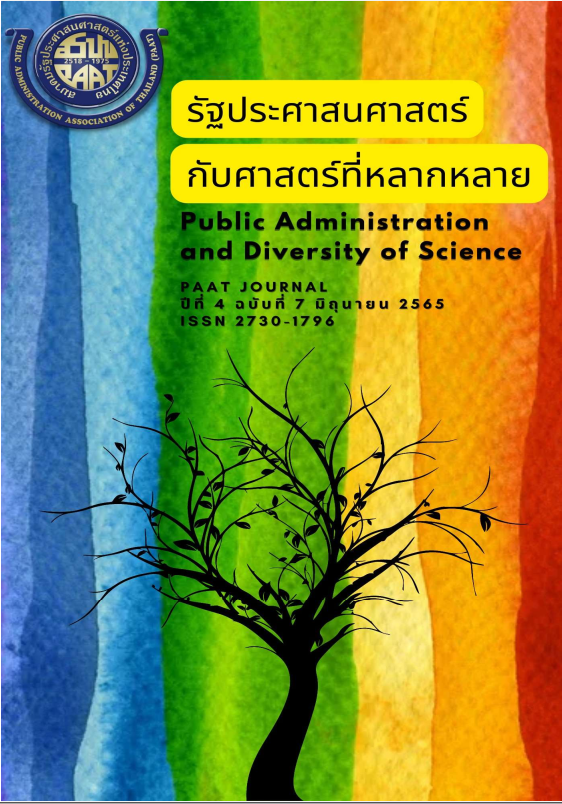การเปลี่ยนแปลงอัตลักษณ์ทางเศรษฐกิจของไต้หวัน และความร่วมมือด้านการลงทุนและการค้า กับไทยและบางประเทศในอาเซียน
คำสำคัญ:
อัตลักษณ์ทางเศรษฐกิจ, ความร่วมมือ, ไต้หวัน, ไทยบทคัดย่อ
บทความวิจัยนี้มีวัตถุประสงค์เพื่อศึกษาการเปลี่ยนแปลงอัตลักษณ์ทางเศรษฐกิจของไต้หวันและ ความร่วมมือด้านการลงทุนและการค้า กับประเทศไทยและบางประเทศในอาเซียนโดยใช้มุมมองของทฤษฎีในสํานัก ประกอบสร้างนิยม การวิจัยเป็นการวิจัยเชิงคุณภาพโดยใช้วิธีการวิจัยเอกสาร ทั้งนี้ข้อมูลทั้งหมดที่ได้จากการ รวบรวมจะถูกนํามาวิเคราะห์โดยใช้วิธีการวิเคราะห์เชิงพรรณนา
ผลการศึกษาพบว่า โลกาภิวัตน์ทางเศรษฐกิจ ตลาดเสรีและค่านิยมประชาธิปไตยในระดับการเมือง ระหว่างประเทศผลักดันให้เกิดความเปลี่ยนแปลงกับโครงสร้างทางเศรษฐกิจภายในไต้หวันที่เริ่มขึ้นตั้งแต่ทศวรรษที่ 1980 โดยไต่หวันได่กําหนดนโยบายพื้นฐานของประเทศได้แก่ การเปิดเสรีทางเศรษฐกิจ การทําให้เป็นนานาชาติ และการสร้างสถาบัน อีกทั้งรัฐบาลยังมีนโยบายให้ความสําคัญกับการส่งเสริมอุตสาหกรรมเทคโนโลยีขั้นสูงแทนที่อุตสาหกรรมที่ใช้แรงงานเข้มข้น ยิ่งไปกว่านั้นภายใต้นโยบายจีนเดียว ทําให้ไต้หวันจําเป็นต้องแสวงหาความร่วมมือ ทางเศรษฐกิจกับรัฐอื่นมากขึ้น โดยเฉพาะความร่วมมือทางด้านการลงทุนและการค้ากับประเทศต่างๆ ในภูมิภาคเอเชียตะวันออกเฉียงใต้ผ่านนโยบายมุ่งใต้และนโยบายมุ่งใต้ใหม่ที่พบว่า ไต้หวันเข้ามาลงทุนในสิงคโปร์มากเป็น อันดับหนึ่ง รองลงมาคือเวียดนามและไทยตามลําดับ สําหรับความร่วมมือด้านการค้าซึ่งศึกษาเฉพาะความร่วมมือกับไทยเท่านั้น พบว่าส่วนใหญ่ไต้หวันเป็นฝ่ายได้เปรียบดุลการค้าไทย
ข้อเสนอแนะเชิงนโยบายคือ รัฐบาลไทยควรเร่งขยายโครงสร้างพื้นฐานขนาดใหญ่เพื่อดึงดูดนักลงทุน ชาวไต้หวัน และรัฐบาลไทยควรร่วมมือกับภาคอุตสาหกรรมไต้หวันในการยกระดับภาคอุตสาหกรรมไทยที่ใช้เทคโนโลยีขั้นสูง
References
กรมเศรษฐกิจระหวางประเทศ กระทรวงการตางประเทศ. (ม.ป.ป.). ขอมูลการค้า-การลงทุน. สืบค้นจาก http://www.thaibiz.net/th/market/Republic-of-Taiwan
กระทรวงพาณิชย์. (2561). การคาไทย. สืบค้นจาก http://www2.ops3.moc.go.th/
ชิ้นส่วนอิเล็กทรอนิกส์ช่วยทุบสถิติการส่งออกของศูนย์วิจัยวิทยาศาสตร์ไต้หวัน. (2560,14 มิถุนายน). สืบค้นจาก http://www.thaibiztaiwan.tw/main/th/news/7200/78496-ชิ้นสวนอิเล็กทรอนิกส์ช่วยทุบสถิติการส่งออกของศูนย.html
ไต้หวันกับการเปลี่ยนผ่านสู่การเป็นประเทศอุตสาหกรรมไฮเทค. (2558, 28 กรกฎาคม). สืบค้นจาก https://www.smethailandclub.com/marketing-816-id.html
วิลคินสัน, พอล. (2557). ความสัมพันธ์ระหว่างประเทศ: ความรู้ฉบับพกพา [International Relations: A Very Short Introduction] (กษิร ชีพเป็นสุข ผู้แปล). กรุงเทพฯ: โอเพ่นเวิลด์.
สมาคมการค้าไทย-ไต้หวัน. (2557, 30 พฤษภาคม). สืบค้นจาก http://www.thaifranchisecenter.com/links/show.php?id=1248
สํานักงานการค้า และเศรษฐกิจไทย (ไทเป). (ม.ป.ป.). ประวัติองค์กร. สืบค้นจาก http://www.tteo.org.tw/main/th/organize/55291-ประวัติองค์กร.html
สํานักงานเศรษฐกิจและวัฒนธรรมไทเป ประจําประเทศไทย. (2559, 16 มิถุนายน). ความสัมพันธ์ระหว่างสํานักงานฯ กับไทย. สืบค้นจาก https://www.roc-taiwan.org/th_th/post/59.html
สํานักงานเศรษฐกิจและวัฒนธรรมไทเป ประจําประเทศไทย. (2019, กันยายน). ไทย-ไตหวันกาวไกลไปกับนโยบายมุงใต้ใหม. กรุงเทพฯ: สํานักงานเศรษฐกิจและวัฒนธรรมไทเป ประจําประเทศไทย
องอาจ เดชอิทธิรัตน์. (2551). เบื้องลึกเบื้องหลังความสัมพันธ์ไทย-ไตหวัน ภายใต้นโยบายจีนเดียว (พิมพ์ครั้งที่ 2). กรุงเทพฯ: โรงพิมพ์มหาวิทยาลัยธรรมศาสตร์.
Aspinwall, Nick (2019, September 26). Taiwan loses 2 diplomatic allies, wins US support ahead of crucial presidential election. Retrieved from https://thediplomat.com/2019/09/taiwanloses-2-diplomatic-allies-wins-us-support-ahead-of-crucial-presidential-election/
Bureau of Foreign Trade, Ministry of Economic Affairs. (2018, November 18). Taiwan's top 15 trade surplus country (region). Retrieved from https://www.trade.gov.tw/english/Pages/Detail.aspx?nodeID=94&pid=651993&dl_DateRange=all&txt_SD=&txt_ED=&txt_Keyword=&Pageid=0
Buszynski, Leszek. (2007, August 22-25). Taiwan’s economic diplomacy towards ASEAN. Retrieved from http://www.cuts-citee.org/CDS02/pdf/CDS02-Session5-03.pdf
Caporaso, James A., & Madeira, Mary Anne. (2012). Globalization, Institutions & Governance. London: SAGE Publications.
Copeland, Dale C. (2006). The constructivist challenge to structural Realism A review essay. In S. Guzzini, & A. Leander (Eds.), Constructivism and International Relations: Alexander Wendt and his critics. (pp. 1-20). London: Routledge. Copper, John F. (2009). Taiwan: Nation-State or Province?. (5th ed.). Philadelphia: Westview Press.
Department of Statistics, Ministry of Finance, Republic of China (Taiwan), Trade Statistics Database, Retrieved from http://web02.mof.gov.tw/njswww/webproxy.aspx?sys=100&funid=edefjsptgl
Huang, Kwei-Bo. (2018). Taiwan’s new southbound policy: Background, objectives, framework and limits. UNISCI Journal, 6, 47-68.
Hoesel, Roger van. (1999). New multinational enterprises from Korea and Taiwan: Beyond export-led growth. New York: Routledge.
Hsinchu Science Park Bureau, Ministry of Science and Technology. (2019, October 16).
Introduction. Retrieved from https://www.sipa.gov.tw/english/home.jsp?serno=201003210014&mserno=201003210003&menudata=EnglishMenu&contlink=content/introduction_1.jsp
Jing, Bo-jiun. (2016). Taiwan and Southeast Asia: Opportunities and constraints of continued engagement. Baltimore, Maryland: University of Maryland School of Law. Retrieved from https://core.ac.uk/download/pdf/56360890.pdf
Kegley, Jr., Charles W., & Blanton, Shannon L. (2013). World politics: trend and transformation. Massachusetts: Wadsworth, Cengage Learning.
Kung, Shiann-Far. & Ottavia , Lin, Yi-Chuan. (2014). Southern Taiwan Science Park. World Technopolis Review. 3(1): 55-61. Doi : http://dx.doi.org/10.7165/wtr2014.3.1.55
Leng, Tse-Kang. (2016). Taiwan and Economic Globalization. In G. Schubert (Ed.), Routledge Handbook of Contemporary Taiwan. (pp. 233 - 250). New York: Routledge.
Matsumura, Masahiro. (2019, April 4). Time for a southbound policy pivot. Retrieved from http://www.taipeitimes.com/News/editorials/archives/2019/04/04/2003712757
Mainland Affairs Council. (2002). Cross-Strait Economic Statistics Monthly No. 124. (p. 29). Retrieved October 5, 2019, from https://ws.mac.gov.tw/001/Upload/OldFile/public/Attachment/ 1101415403049. pdf
Mainland Affairs Council. (2003). Cross-Strait Economic Statistics Monthly No. 136. (p. 29). Retrieved October 5, 2019, from https://ws.mac.gov.tw/001/Upload/OldFile/public/Attachment/1101110281747.pdf
Mainland Affairs Council. (2004). Cross-Strait Economic Statistics Monthly No. 146. (p. 33). Retrieved October 5, 2019, from https://ws.mac.gov.tw/001/Upload/OldFile/public/MMO/MAC/%E5%85%A9%E5%B2%B8%E7%B6%93%E6%BF%9F%E7%B5%B1%E8%A8%88%E6%9C%88%E5%A0%B1no.14613.pdf
Mainland Affairs Council. (2005). Cross-Strait Economic Statistics Monthly No. 157. (p. 33). Retrieved October 5, 2019, from https://ws.mac.gov.tw/001/Upload/OldFile/public/MMO/MAC/%E5%85%A9%E5%B2%B8%E7%B6%93%E6%BF%9F%E7%B5%B1%E8%A8%88%E6%9C%88%E5%A0%B1no.15713.pdf
Mainland Affairs Council. (2006). Cross-Strait Economic Statistics Monthly No. 169. (p. 33). Retrieved October 5, 2019, from https://ws.mac.gov.tw/001/Upload/OldFile/public/MMO/MAC/%E5%85%A9%E5%B2%B8%E7%B6%93%E6%BF%9F%E7%B5%B1%E8%A8%88%E6%9C%88%E5%A0%B1no.16913.pdf
Mainland Affairs Council. (2007). Cross-Strait Economic Statistics Monthly No. 181. (p. 31). Retrieved October 5, 2019, from https://ws.mac.gov.tw/001/Upload/OldFile/public/MMO/MAC/%E5%85%A9%E5%B2%B8%E7%B6%93%E6%BF%9F%E7%B5%B1%E8%A8%88%E6%9C%88%E5%A0%B1no.18113.pdf
Mainland Affairs Council. (2016). Cross-Strait Economic Statistics Monthly No. 284. (p. 2-9, p. 2-12). Retrieved September 28, 2019, from https://ws.mac.gov.tw/001/Upload/OldFile/public/MMO/MAC/284_7.pdf
Mainland Affairs Council. (2016). Cross-Strait Economic Statistics Monthly No. 284. (p. 2-12). Retrieved October 5, 2019, from https://ws.mac.gov.tw/001/Upload/OldFile/public/MMO/MAC/284_10.pdf
Mainland Affairs Council. (2017). Cross-Strait Economic Statistics Monthly No. 296. (p. 2-10). Retrieved September 28, 2019, fromhttps://ws.mac.gov.tw/Download.ashx?u=LzAwMS9VcGxvYWQvMjk3L2NrZmlsZS8yOTIwNzcxNS1jMGFiLTQyMjEtODM1My1kODMzNTRmYWYwNWYucGRm&n=Mjk2IEZ1bGwgVGV4dC5
wZGY%3d
Mainland Affairs Council. (2017). Cross-Strait Economic Statistics Monthly No. 296. (p. 2-13). Retrieved October 5, 2019, from https://ws.mac.gov.tw/Download.ashx?u=LzAwMS9VcGxvYWQvMjk3L2NrZmlsZS8yOTIwNzcxNS1jMGFiLTQyMjEtODM1My1kODMzNTRmYWYwNWYucGRm&n=Mjk2IEZ1bGwgVGV4dC5wZGY%3d
Mainland Affairs Council. (2018). Cross-Strait Economic Statistics Monthly No. 308. (p. 2-10). Retrieved September 28, 2019, from https://ws.mac.gov.tw/Download.ashx?u=LzAwMS9VcGxvYWQvMjk3L2NrZmlsZS80N2IxYWMwYi01MDMyLTQ4M2ItYTQyZC00N2Q3Y2NjYmE5NWIucGRm&n=MzA4IEZ1bGwgVGV4dC5wZGY%3d
Mainland Affairs Council. (2018). Cross-Strait Economic Statistics Monthly No. 308. (p. 2-13). Retrieved October 5, 2019, from https://ws.mac.gov.tw/Download.ashx?u=LzAwMS9VcGxvYWQvMjk3L2NrZmlsZS80N2IxYWMwYi01MDMyLTQ4M2ItYTQyZC00N2Q3Y2NjYmE5NWIucGRm&n=MzA4IEZ1bGwgVGV4dC5wZGY%3d
Mainland Affairs Council. (2019). Cross-Strait Economic Statistics Monthly No. 318. (p. 2-10). Retrieved September 28, 2019, from https://ws.mac.gov.tw/Download.ashx?u=LzAwMS9VcGxvYWQvMjk3L2NrZmlsZS8yY2Q1N2UwMC05ZTJjLTRiZjEtYjMwMC0xMzA4ODkwNDUwMjAucGRm&n=MzE4IEZ1bGwgVGV4dC5wZGY%3d
Mainland Affairs Council. (2019). Cross-Strait Economic Statistics Monthly No. 318. (p. 2-13). Retrieved October 5, 2019, from https://ws.mac.gov.tw/Download.ashx?u=LzAwMS9VcGxvYWQvMjk3L2NrZmlsZS8yY2Q1N2UwMC05ZTJjLTRiZjEtYjMwMC0xMzA4ODkwNDUwMjAucGRm&n=MzE4IEZ1bGwgVGV4dC5wZGY%3d
Marston, Hunter. & Bush, Richard C. (2018). Taiwan’s engagement with Southeast Asia is making progress under the New Southbound Policy, Retrieved July 10, 2019, from https://www.brookings.edu/opinions/taiwans-engagement-with-southeast-asia-is-makingprogress-under-the-new-southbound-policy/
Ngeow, Chow Bing. (2017). Taiwan’s Go South Policy: Deja vu All Over Again?. Contemporary Southeast Asia, 39(1), 96-126. Doi:10.1355/cs39-lc.
Startup Genome. (2019, January 14). Three Sub-Sectors We're Watching in Taipei City. Retrieved June 8, 2019, from https://startupgenome.com/blog/member-spotlight-three-sub-sectorswere-watching-in-taipei-city
Taiwan down to 20 allies as Beijing steps up the pressure. (2017, June 13). Retrieved from http://www.foxnews.com/world/2017/06/13/taiwan-down-to-20-allies-as-beijing-steps-uppressure.html
Taiwan-Thailand Economic Relations. (n.d.). Retrieved from https://www.trade.gov.tw/App_Ashx/File.ashx?FilePath=../Files/PageFile/659922/%E6%B3%B0%E5%9C%8B%E8%8B%B1%E6%96%87%E7%B6%93%E8%B2%BF%E7%B0%A1%E7%95%A5%E7%89%88_1080219.pdf
Tian, John Q. (2006). Government, business, and the politics of interdependence and conflict across the Taiwan Strait. New York: Palgrave Macmillan.
Waltz, Kenneth. (1979). Theory of International Politics. Massachusetts: Addison-Wesley Publishing Company.
Wendt, Alexander. (1992, Spring). Anarchy is what states make of it: The social construction of power politics. International Organization, 46 (2), 391-425.
Wong, Joseph. (2016). The Developmental State and Taiwan: Origins and Adaptation. In G. Schubert (Ed.), Routledge Handbook of Contemporary Taiwan. (pp. 201 - 217). New York: Routledge.
Zehfuss, Maja. (2002). Constructivism in international relations the politics of reality. Cambridge: Cambridge University Press.
Zheng, Yu. (2013). Governance and foreign investment in China, India, and Taiwan: Credibility, flexibility, and international business. Michigan: The University of Michigan Press.
Downloads
เผยแพร่แล้ว
How to Cite
ฉบับ
บท
License

This work is licensed under a Creative Commons Attribution-NonCommercial-NoDerivatives 4.0 International License.


